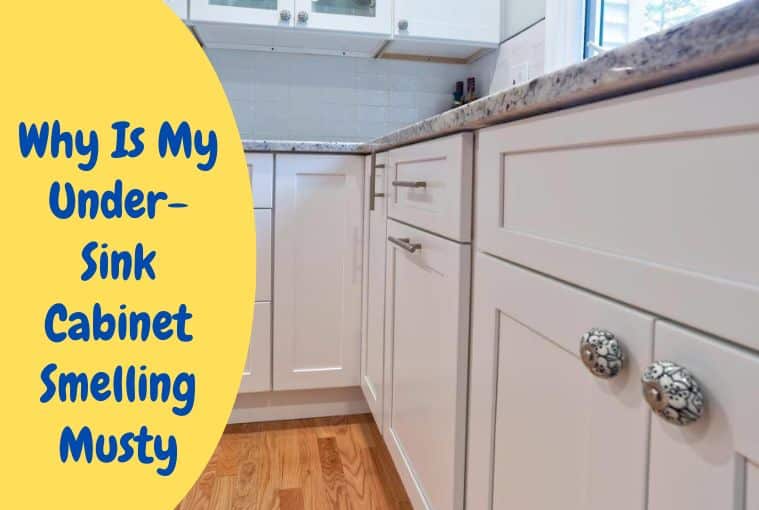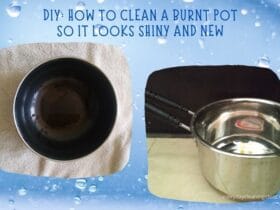Is there a musty smell coming from your kitchen cabinets? And you can not find the answer to why this musty smell in the cabinet under the sink is so persistent and bad? Then this article is just for you.
A musty odor emanating from the under-sink cabinet can be both unpleasant and concerning for homeowners. This unwelcome smell not only affects the overall ambiance of your kitchen but can also be an indicator of underlying issues.
But worry not, I am here to answer all your doubts and questions. Through this article, I will delve into the reasons why under-sink cabinets can develop a musty smell, explore the role of mold and mildew in causing these odors, discuss the harmful effects, and provide practical solutions to eliminate the issue.
6 Alarming Reasons Why Your Under-Sink Cabinets Smell Musty
Under-sink cabinets can develop a musty smell for various reasons, with mold and mildew growth being the most prominent contributors. Let’s go through these six reasons in detail, placing a particular emphasis on the role of mold and mildew:
1. Moisture Accumulation
Mold and mildew require moisture to thrive, and under-sink areas are particularly susceptible to moisture accumulation due to plumbing fixtures and sink usage.
Water leaks, dripping pipes, or even condensation can lead to excess moisture under the sink, creating the perfect environment for mold and mildew growth.
When moisture accumulates in the cabinet’s dark and poorly ventilated environment, it provides the necessary conditions for mold and mildew spores to settle and multiply.
Mold and mildew are types of fungi that belong to the fungal kingdom. They are simple organisms that thrive in various environments but are particularly well-suited to places with high humidity, moisture, and organic matter to feed on.
When mold and mildew colonies grow, they release volatile organic compounds (VOCs) that produce the musty odor commonly associated with them. These VOCs generate an unpleasant smell that permeates the cabinet and can even spread to nearby areas.
It’s important to note that not all molds and mildews produce the same types or quantities of VOCs, so the specific odor can vary depending on the species and environmental conditions.
Additionally, the presence of these VOCs can have adverse health effects, particularly for individuals with mold allergies or sensitivities, making it essential to address mold and mildew growth promptly and effectively.
2. Inadequate Ventilation
Proper ventilation is crucial to dissipate moisture and prevent the buildup of humidity.
Under-sink cabinets often lack adequate ventilation, as they are typically enclosed spaces with limited airflow.
Without sufficient ventilation, moist air becomes trapped inside the cabinet, promoting the growth of mold and mildew.
3. Organic Matter Accumulation
Spills, food debris, and cleaning product residues can accumulate under the sink over time.
These organic materials serve as a food source for mold and mildew, allowing them to colonize and thrive.
As mold and mildew consume these organic substances, they release enzymes and volatile organic compounds (VOCs), contributing to the musty odor.
4. Hidden Leaks
Undetected water leaks from plumbing connections, seals, or the sink itself are common culprits in under-sink cabinets.
These hidden leaks can persist for extended periods without detection, allowing water to penetrate the cabinet’s wooden or particleboard structure.
As the material becomes saturated, it becomes a prime breeding ground for mold and mildew, which further amplifies the musty smell.
5. Lack of Regular Cleaning
Neglecting to clean the interior of the under-sink cabinet regularly can lead to the accumulation of dirt, dust, and grime.
These contaminants can provide a surface for mold spores to settle and germinate.
Mold and mildew can also feed on the organic residues left behind by cleaning products if they are not properly rinsed.
6. Old or Damaged Cabinets:
Aging, old-wood cabinets, or water-damaged cabinets are more susceptible to moisture infiltration.
Over time, the structural integrity of the cabinet can be compromised, creating openings for water to seep in.
The porous nature of water-damaged wood or particleboard provides an ideal habitat for mold and mildew growth, which is a primary source of the musty odor.
Mold and mildew growth is a significant contributor to the musty smell in under-sink cabinets due to their dependence on moisture and organic matter for survival.
Addressing moisture issues, improving ventilation, maintaining cleanliness, and promptly addressing any leaks or cabinet damage are essential steps in preventing and remedying musty odors in these areas of your home.
6 Harmful Effects of Musty Cabinets
Musty cabinets can have several harmful effects on both your home and your health. Understanding these consequences is crucial for taking timely action to prevent and remediate musty odors. Here, I have listed six harmful effects of musty cabinets in detail:
- Health Concerns
-
- One of the most significant and immediate concerns associated with musty cabinets is health-related. The musty odor is often indicative of mold and mildew growth, and mold exposure can lead to various health issues.
- Mold produces allergenic substances and mycotoxins that can trigger allergic reactions, respiratory problems, skin irritation, eye irritation, coughing, sneezing, and worsen conditions like asthma.
- Prolonged exposure to mold spores and mycotoxins can lead to more severe health problems, especially in individuals with compromised immune systems.
- Structural Damage
-
- Mold and mildew growth not only affect your health but also the structural integrity of your cabinets and the surrounding area.
- Musty odors often signal the presence of hidden moisture and water damage, which can lead to the decay of wood or particleboard materials. This can compromise the cabinet’s structural stability and may necessitate costly repairs or replacements.
- Unpleasant Kitchen Environment
-
- A musty odor can make your kitchen an unpleasant place to be. Cooking, dining, or spending time in a kitchen with a persistent musty smell can be quite uncomfortable and affect your overall enjoyment of the space.
- Contaminated Contents
-
- Items stored in a musty cabinet can absorb the unpleasant odor, potentially affecting the taste and quality of food, cleaning supplies, and other stored goods.
- Additionally, the presence of mold spores in the cabinet’s air can lead to cross-contamination, making it important to inspect and clean any items stored in the cabinet.
- Reduced Home Value
-
- If you plan to sell your home in the future, the presence of musty odors, visible mold or mildew growth, or documented water damage can significantly lower your property’s market value.
- Prospective buyers may be deterred by the potential health hazards and costly remediation required to address these issues.
- Increased Energy Costs
-
- Mold and mildew growth can damage insulation in your cabinets or surrounding walls. This damage can result in reduced energy efficiency in your home.
- As insulation deteriorates, your heating and cooling systems may have to work harder to maintain a comfortable temperature, potentially leading to increased energy costs over time.
To mitigate these harmful effects, it’s essential to address the root causes of musty odors promptly.
Regular inspections and maintenance can help ensure that your cabinets remain odor-free and your home environment remains healthy and comfortable.
Musty Cabinets No More! Learn How to Get Rid of That Unpleasant Smell Today!
Addressing the musty smell in under-sink cabinets requires a combination of preventive measures and specific solutions. I have outlined a detailed breakdown of solutions to the problem:
- Identify and Fix Leaks
- Start by thoroughly inspecting your plumbing connections, seals, and the sink itself for any signs of leakage.
- If you find leaks, repair them promptly. Replace damaged seals, tighten loose connections, or seek professional plumbing assistance if needed.
- Fixing leaks is crucial to prevent further moisture infiltration, which is a primary cause of mold and mildew growth.
- Improve Ventilation
- Enhance the airflow within the cabinet by installing ventilation grilles or louvered doors.
- Leave cabinet doors slightly ajar to allow better air circulation. This will help reduce moisture buildup.
- Consider using small battery-operated or plug-in fans to keep air moving within the cabinet, especially if it lacks natural ventilation.
- Keep it Clean
- Empty the cabinet and clean its interior thoroughly. Remove all items, including cleaning supplies and stored goods.
- Use a mixture of water and vinegar or a mild detergent to clean the surfaces inside the cabinet. Scrub away any visible mold or mildew growth using a scrub brush.
- Rinse and dry the cabinet thoroughly before placing items back inside. Regular cleaning prevents the buildup of organic matter that can support mold growth.
- Use Dehumidifiers
- Consider placing a small, battery-operated dehumidifier or moisture absorber inside the cabinet.
- These devices help maintain low humidity levels, making them less conducive for mold and mildew growth.
- Replace Damaged Cabinets
- If your under-sink cabinet is old, extensively damaged, or made of materials prone to moisture absorption, consider replacing it with water-resistant options.
- Materials like moisture-resistant plywood, solid wood treated with water-resistant finishes, or plastic laminates are better choices for cabinets in areas prone to moisture.
- Seal and Insulate
- Seal any gaps or cracks in the cabinet’s structure, especially around plumbing fixtures and seams. This prevents moisture from seeping into the cabinet.
- Consider insulating the cabinet’s interior walls with moisture-resistant materials like closed-cell foam to create a barrier against temperature fluctuations and moisture intrusion.
- Monitor and Prevent Future Issues
- Regularly inspect the cabinet for any signs of moisture or mold growth, even after implementing the above solutions.
- Address any leaks, condensation, or plumbing issues as soon as they arise to prevent recurrence.
- Store items in airtight containers to reduce the risk of contamination in case mold or mildew reappears.
- Address Mold and Mildew Directly
- If you discover extensive mold or mildew growth, it’s essential to address it directly. Wear protective gear, such as gloves and a mask, and follow proper cleaning and removal protocols.
- Scrub visible mold with a mixture of water and detergent, rinse thoroughly, and allow the area to dry completely.
- Consider using mold-specific cleaning products or seeking professional remediation for severe cases.
By implementing these solutions and maintaining a proactive approach to preventing moisture-related issues, you can effectively eliminate musty odors from your under-sink cabinet and create a healthier and more pleasant kitchen environment.
How to Deodorize the Under-Sink Cabinet
In this section, I have mentioned a few ways to deodorize your kitchen cabinets. This will help you eliminate the musty odor and keep your kitchen fragrant and fresh in the future:
- Remove Contents: Empty the cabinet and clean its interior thoroughly.
- Use Baking Soda: Place an open container of baking soda or activated charcoal inside the cabinet. These absorb odors over time.
- Apply Odor Absorbers: Use commercial odor absorbers or natural options like coffee grounds, citrus peels, or cedar blocks to help neutralize smells.
- Regular Maintenance: Continue to inspect and clean the cabinet periodically to prevent the return of musty odors.
Conclusion
A musty-smelling under-sink cabinet is not only a nuisance but also a potential indicator of more significant issues, such as mold and mildew growth.
Addressing the root causes of these odors and implementing preventive measures is essential to maintain a clean, healthy, and pleasant kitchen environment.
By following the solutions and deodorization methods outlined in this article, you can ensure your under-sink cabinet remains odor-free and in excellent condition. Happy cleaning!
Read here-









Leave a Reply
View Comments